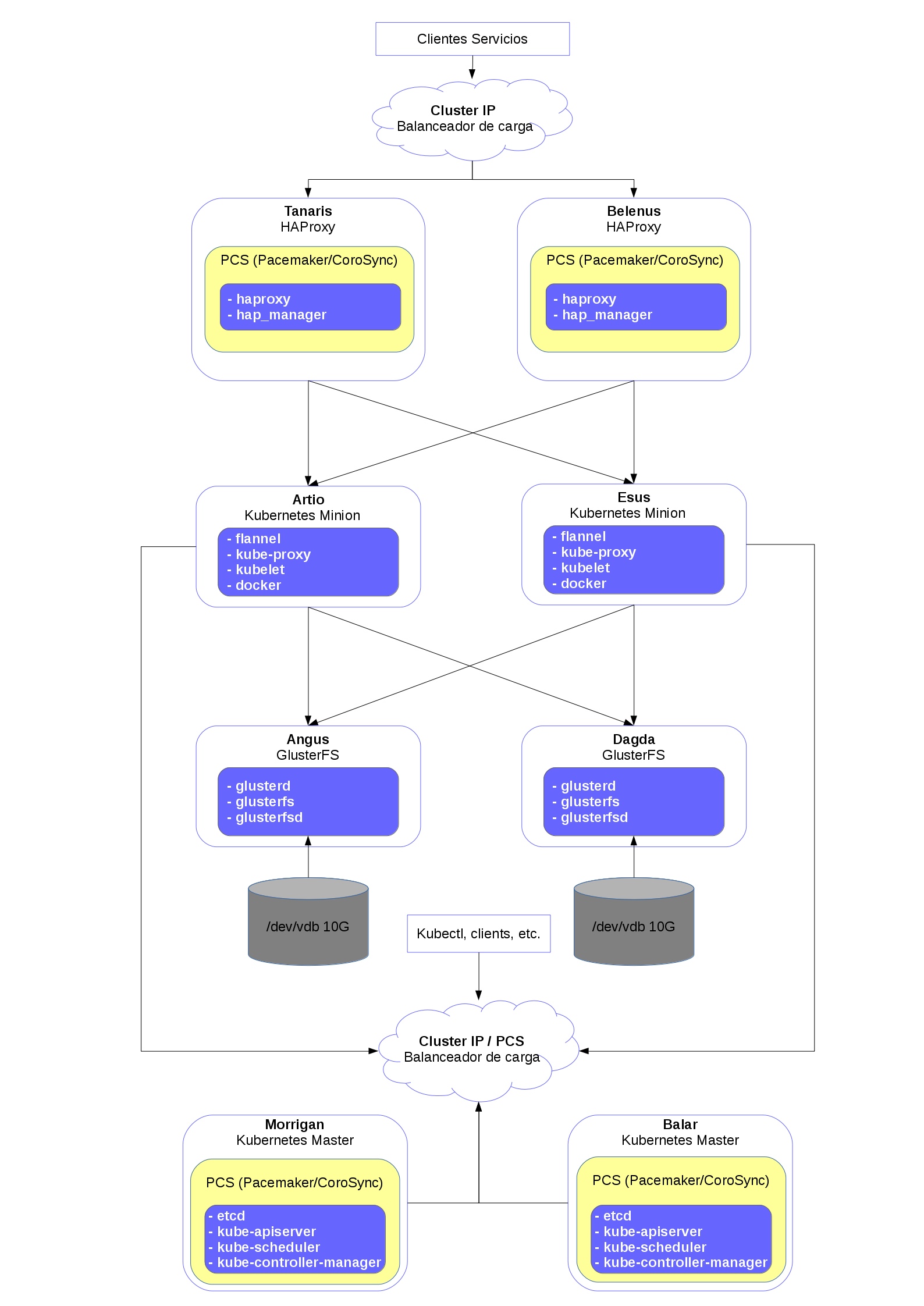Deploy kubernetes on the fly, the project creates a HA kubernetes cluster two master nodes, two minions nodes and two poxies nodes, it uses Vagrant with KVM as infrastecture provider (IaaS) and
Ansible as configuration manager to automatically have a ready and functional HA kubernetes cluster
in less than 15 minutes.
Finally it deploys two kubernetes nginx services these two test the balance between proxies for different requests and an api to make a request to the proxies from a browser.
As an extra the entire HA kubernetes cluster can be scalable if wished, the project has a k8s-scale project to add a new minion to the existing cluster.
Reference: http://tedezed.github.io/Celtic-Kubernetes/HTML/3-Kube_HA_pcs.html
- Localhost machine with Linux distribution
- KVM
- Vagrant 1.8.1 or higher
- Vagrant libvirt plugin for KVM
- Ansible 2.2.1 or higher
The first thing is check that you localhost support virtualization, just type
egrep -c '(vmx|svm)' /proc/cpuinfo if the result is 0, your localhost does not support it,
in other case > 0, means you locahost support virtualization, but also must be ensured it is enable
in the BIOS. Once it is assured procced to install kvm (https://www.linux-kvm.org/page/Downloads).
Next to complete the environment and reproduce the kubernetes cluster,
with the use of Vagrant just install it (https://www.vagrantup.com/) on your localhost and must be
installed Ansible also (http://docs.ansible.com/ansible/latest/intro_installation.html).
In the other hand to use kvm to setup kubernetes cluster nodes, must be installed the vagrant libvirt provider,
it is a plugin for vagrant to use with libvirt API to manage kvm as infraestructure provider.
(https://github.com/vagrant-libvirt/vagrant-libvirt#installation)
Finally we need a Public RSA Key to inject in the Kubernetes Cluster nodes, therefore if you have already
one fine, it is going to be used later, otherwise proceed to Generate SSH Keys in your localhost
(https://www.cyberciti.biz/faq/linux-unix-generating-ssh-keys/)
-
In the localhost just clone the repository
git clone https://github.com/jvalderrama/k8s-hacluster.git -
Go inside the folder k8s-hacluster
cd k8s-hacluster -
Set your
Publis RSA Keyin the scriptscripts/prepare_cluster.py, generally it is located in ~/.ssh/id_rsa.pub -
Start up the
Kubernetes Cluster
vagrant up --provider libvirt
That's all ...
Now check the entire cluster with the next tips
-
Go to minion-1 node and check nodes
vagrant ssh Alcazaba-minion-1
kubectl -s http://10.10.10.69:8080 get nodesit must show the two minions nodes ready and working -
Go to minion-2 node and check nodes
vagrant ssh Caballo-minion-2
kubectl config set-cluster test-cluster --server=http://10.10.10.69:8080
kubectl config set-context test-cluster --cluster=test-cluster
kubectl config use-context test-cluster
kubectl get nodesit must show the two minions nodes ready and working -
Go to master node and check nodes
vagrant ssh Mulhacen-master-1
kubectl cluster-infosudo pcs cluster status
sudo pcs resource show -
Go to proxy-1 node and check nodes
vagrant ssh Caldera-proxy-1
sudo pcs cluster status
sudo pcs resource show -
Finally in localhost check the "Nginx services welcome page"
curl 10.10.10.68/nginx-service-domain/
curl 10.10.10.68/nginx-service-domain-2/From a browser
http://10.10.10.68:8080/avg/authservice/rest/imsi
Follow the next steps to scale up your entire cluster
-
Go inside the folder k8s-scale
cd k8s-hacluster/k8s-scale/ -
Start up the new Minion node to add in the
Kubernetes Cluster
vagrant up --provider libvirt -
Go to master node and check minion nodes
vagrant ssh Mulhacen-master-1
kubectl get nodes -
Go to master node and check minion nodes (Must be appears three nodes)
vagrant ssh Mulhacen-master-1
kubectl get nodes -
Deploy a new pod inside the new minion node
Replace file in /tmp/avg-api-rc.yml in line 6 **replicas: 2** key by **replicas: 3**
kubectl replace rc --filename=/tmp/avg-api-rc.yml -
Check the new pod deployed in the new minion node (Must be appears three avg-api-controller-*, one of these deployed in the new minion node)
kubectl get pods
That's all, cluster has been scaled up !!!
Thanks also to my partners @Noel_illo (Noel Ruiz Lopez) and @M4nu_sL (Manuel Sanchez Lopez) for your great job :)
